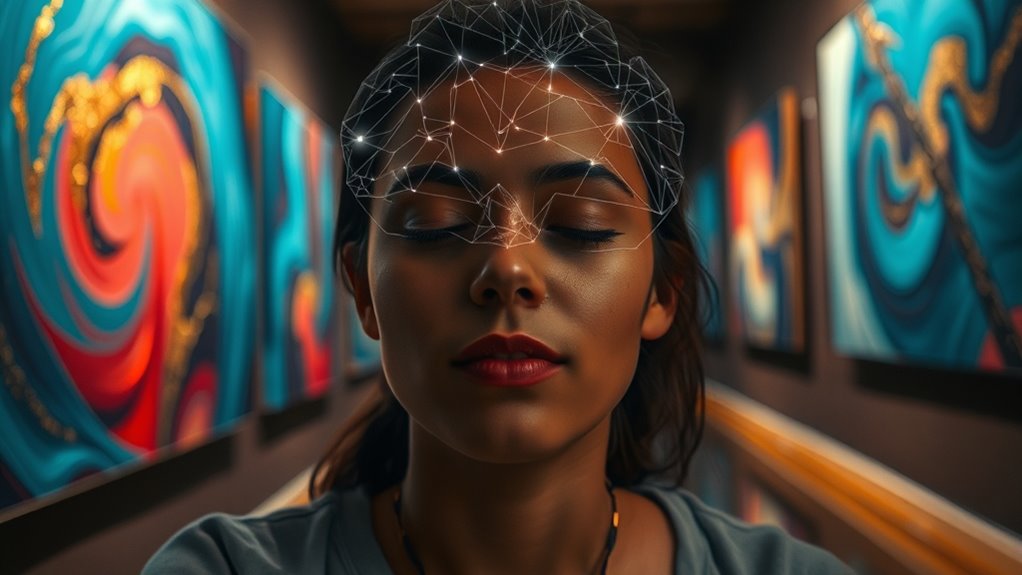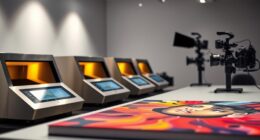When you view art, your brain activates intricate neural pathways that link sensory areas like the visual and auditory cortex with emotional and memory centers. This process stimulates the release of neurochemicals such as dopamine and endorphins, which boost your mood and create feelings of pleasure, awe, or reflection. The way your brain responds depends on your personal experiences and cultural background, shaping your emotional journey. Keep exploring to discover how these neural connections influence your everyday mood and perception.
Key Takeaways
- Viewing art activates neural pathways linking visual, auditory, and emotional brain regions, creating multisensory experiences.
- Art stimulates the release of neurochemicals like dopamine and endorphins, enhancing feelings of pleasure and reward.
- Emotional responses to art depend on neural connections influenced by personal, cultural, and contextual factors.
- Engaging with art promotes neuroplasticity, strengthening neural networks related to empathy, creativity, and emotional regulation.
- Personal interpretation of art involves neural pathways that connect sensory input to memories and feelings, impacting mood.

Have you ever wondered what happens in your brain when you experience art? When you gaze at a painting or listen to a symphony, your brain springs into action, creating complex neural pathways that process the sensory input. These pathways connect various regions responsible for visual perception, sound, and emotion, allowing you to interpret and find meaning in what you’re experiencing. As you engage with art, your brain doesn’t just passively receive information; it actively constructs a rich, multisensory experience. This integration stimulates areas like the visual cortex, auditory cortex, and associative regions that link sensory input with memories and emotions. The result is a deeply personal encounter that can evoke powerful emotional responses, altering your mood and perception.
When experiencing art, your brain actively connects sensory input with emotions, creating a personalized and meaningful neural journey.
Your emotional responses are a essential part of how art affects you. When you look at a painting or listen to music, your brain responds by releasing neurochemicals like dopamine and endorphins, which are associated with pleasure and reward. These chemical reactions are tied to the activation of neural pathways that process emotional stimuli, reinforcing your feelings of joy, awe, or even sadness. Different artworks trigger different emotional responses based on your personal experiences, cultural background, and current mood. For instance, vibrant colors and lively compositions might energize you, while somber tones could evoke introspection or melancholy. This dynamic interplay between sensory input and emotional processing underscores why art can have such a profound impact on your mood.
Furthermore, the neural pathways involved in processing art aren’t fixed; they adapt and strengthen over time through a process called neuroplasticity. When you regularly engage with art, your brain becomes more efficient at connecting sensory and emotional regions. This can enhance your capacity for empathy, creativity, and emotional regulation. Additionally, engaging with diverse forms of art can stimulate the visual and auditory cortex, broadening your neural networks and enriching your emotional responses. The emotional responses you experience while viewing art are also influenced by your brain’s ability to recall past memories associated with similar stimuli, creating a cycle that deepens your connection to the artwork. So, when you stand before a piece of art, your brain isn’t just passively observing—it’s actively building a network of neural connections that shape your emotional landscape.
In essence, experiencing art is a deeply neural and emotional journey. Your brain’s neural pathways light up with activity, linking sensory data to feelings and memories. These pathways help you interpret and emotionally connect with art, making each experience uniquely yours. The emotional responses you have are not random; they’re rooted in your brain’s intricate wiring, which constantly adapts and evolves with your encounters with art. So next time you stand before a masterpiece, remember that your brain is working hard, weaving together sensory impressions and emotional responses to create a moment of personal significance.
Frequently Asked Questions
How Does Prolonged Art Viewing Impact Brain Plasticity?
When you view art for an extended period, your brain experiences neural adaptation, which enhances your ability to process visual details and emotional cues. This sustained exposure also promotes sensory integration, helping different brain regions work together more efficiently. As a result, your brain’s plasticity increases, making it more flexible and responsive to new artistic styles or challenges. So, prolonged art viewing actively strengthens your brain’s adaptability and perceptual skills.
Can Art Therapy Help Recover From Neurological Injuries?
Yes, art therapy can markedly aid your recovery from neurological injuries. It promotes neuroplasticity improvement by engaging your brain in creative activities, which helps rewire neural pathways. This process supports emotional healing, reduces stress, and boosts mood. Visualizing your progress through art can inspire motivation and resilience, making therapy more effective. Ultimately, engaging in art therapy provides a powerful, personalized tool to enhance your brain’s healing capacity.
What Are the Differences in Brain Response to Abstract Versus Realistic Art?
When you view abstract art, your visual cortex processes its shapes and colors more intensely, often engaging areas linked to imagination and emotion. Realistic art, on the other hand, activates your visual cortex for detailed recognition and stimulates emotional processing tied to familiar scenes. You may find abstract pieces evoke personal feelings and creativity, while realistic art triggers recognition and nostalgic responses, creating distinct brain response patterns for each type.
How Do Individual Differences Influence Art Perception and Emotional Response?
Your perception of art is a unique dance, shaped by personality traits and cultural background. These differences act like a palette, tinting your emotional response and how your brain interprets colors and shapes. You might find solace in abstract forms or resonance in realistic scenes, all influenced by your life experiences. Embracing these variations enriches your artistic journey, making each encounter a personal masterpiece.
Are There Specific Neural Pathways Involved in Aesthetic Appreciation?
You activate specific neural circuits during aesthetic appreciation, mainly involving the orbitofrontal cortex, limbic system, and visual areas. These pathways process sensory input, evaluate beauty, and evoke emotions, creating a rich experience. When you view art, your brain integrates these signals through neural circuits dedicated to aesthetic processing, shaping your emotional response and overall perception of the artwork. This intricate network underpins how you experience beauty and artistic value.
Conclusion
As you explore how art influences your brain and mood, it’s fascinating to contemplate that viewing art might activate neural pathways linked to empathy and emotional regulation. While some theories suggest art can directly stimulate happiness centers, research indicates these effects are complex and personalized. You might find that your emotional response is shaped by both your unique neural wiring and the art’s context, highlighting how deeply intertwined your brain and artistic experiences truly are.








